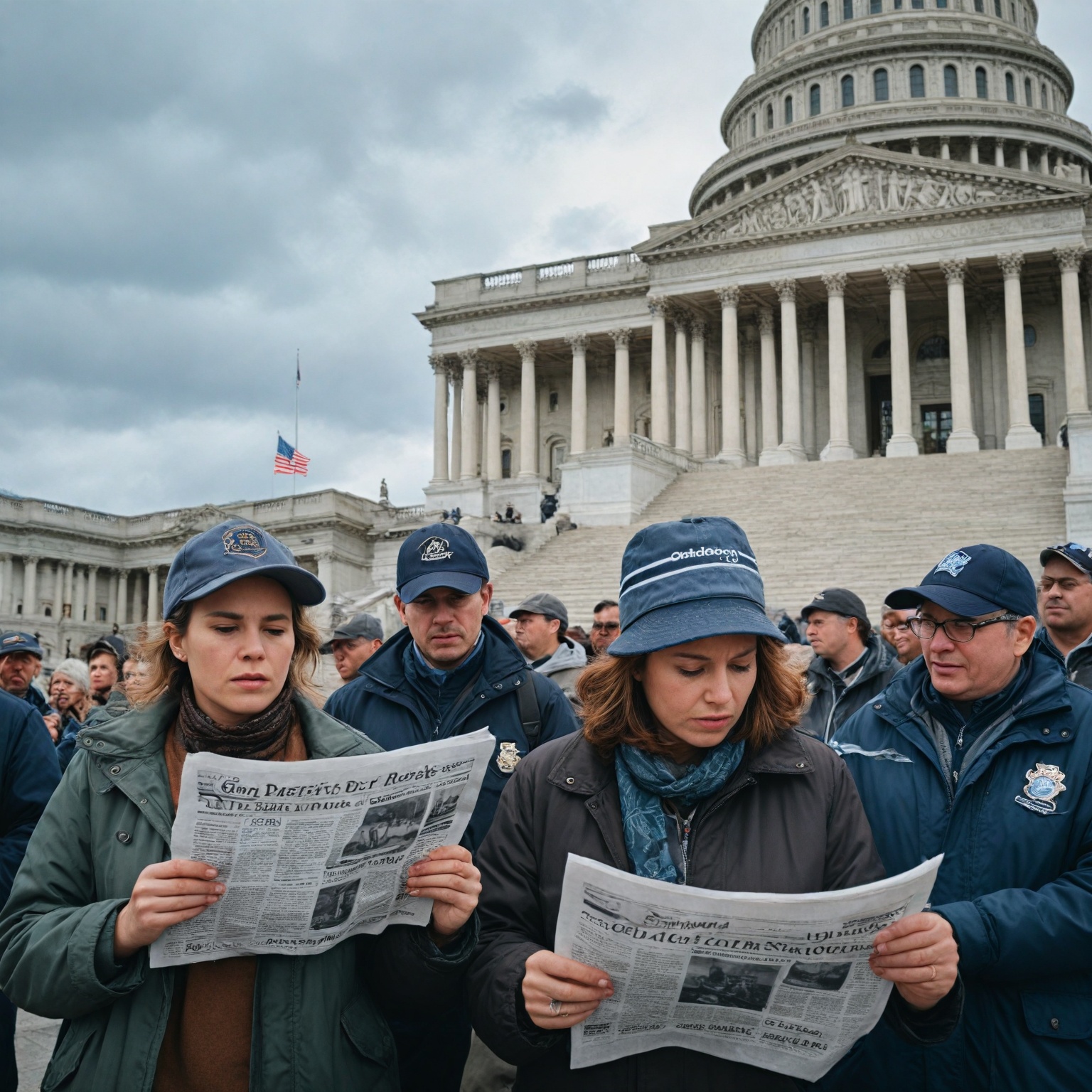Summary
The failure of the United States Senate to pass a continuing resolution in late September 2025 triggered a government shutdown, marking the first such lapse since 2019. The shutdown arose after the Senate rejected a House-passed short-term funding bill designed to extend federal government operations through mid-November, primarily due to partisan disagreements over healthcare provisions and other policy priorities. The Senate vote fell short of the 60-vote threshold required to overcome the filibuster, with both Democratic and Republican proposals failing to garner sufficient bipartisan support.
Government shutdowns occur when Congress fails to enact appropriations or continuing resolutions before the start of the fiscal year, forcing many federal agencies to suspend operations and furlough employees. This shutdown disrupted numerous services, including air traffic control, healthcare programs, flood insurance, and nutrition assistance for vulnerable populations, while imposing financial hardships on hundreds of thousands of federal workers required to work without immediate pay or be furloughed. Economic analysts warned of negative impacts on economic growth and market confidence if the impasse continued, referencing the significant economic losses caused by the 2018–2019 shutdown.
The legislative stalemate underscored enduring procedural and political challenges in Congress, particularly the Senate’s filibuster rule, which requires a 60-vote supermajority to advance most legislation. Political polarization and competing priorities between Senate Democrats and Republicans contributed to repeated failures to pass stopgap funding measures. Negotiations also involved broader policy debates, including the extension of Affordable Care Act subsidies and Medicaid funding, further complicating efforts to reach consensus.
Efforts to resolve the shutdown have included multiple rounds of votes on competing proposals and discussions of shorter-term extensions to allow more time for negotiation. Congressional leaders from both parties have indicated a willingness to negotiate, though progress remains stalled amid deep partisan divisions. The shutdown has reignited debates over legislative procedures and the challenges of bipartisan governance in a polarized political environment.

Background
The United States federal government relies on annual appropriations bills to fund discretionary programs for each fiscal year, which begins on October 1. If Congress fails to enact these appropriations before the start of the fiscal year, it typically passes a continuing resolution (CR) to provide temporary funding and prevent a government shutdown. This has been a recurring pattern, as Congress has needed to pass CRs in 42 of the last 45 years due to delays in completing appropriations legislation.
When neither appropriations bills nor continuing resolutions are approved and signed by the President, affected federal agencies and programs must largely cease operations, resulting in a government shutdown. Although the shutdown process has occurred multiple times historically, it causes widespread disruption, including furloughing federal employees, halting services such as flood insurance and healthcare, and suspending nutrition support programs for vulnerable populations.
The budget process begins each year with the President submitting a budget proposal to Congress by the first Monday in February, which outlines recommended spending levels and revenue estimates for the upcoming fiscal year. Following this, Congress considers and adopts a budget resolution, which guides the subsequent appropriations bills. However, political divisions in Congress often hinder timely agreement on these funding measures. The failure to pass either a full-year appropriations bill or a continuing resolution has repeatedly resulted in government shutdowns, including the one that began on October 1, 2025, after the Senate rejected a House-passed continuing resolution intended to prevent the shutdown.
In the current shutdown scenario, House Speaker Mike Johnson canceled a planned work period in Washington and instructed lawmakers to remain in their districts, emphasizing that the House would only resume work when Senate Minority Leader Chuck Schumer allowed the government to reopen. This deadlock reflects the ongoing partisan struggles in Congress over government funding and the difficulty in reaching consensus on stopgap spending measures.
Legislative Context and Political Environment
The legislative process surrounding government funding bills is shaped by both procedural rules and the political dynamics within Congress. One significant procedural hurdle is the Senate cloture rule, which requires a supermajority of 60 votes to end debate on most measures and move to a vote. This rule effectively empowers the minority party to filibuster legislation, making it difficult for the majority to pass bills without bipartisan support or procedural exceptions. However, certain types of legislation, such as those passed under the budget reconciliation process, allow for a simple majority vote by limiting debate time, thereby circumventing the filibuster. Budget reconciliation is often used for bills addressing entitlement spending and revenue provisions, and it has become a critical tool in navigating Senate gridlock.
Congress has historically used other legislative mechanisms to manage funding limits, including “bipartisan budget acts” enacted in 2013, 2015, 2018, and 2019. These acts raised the funding limits on defense and non-defense appropriations established by the 2011 Budget Control Act. Through deeming resolutions and statutory provisions, these bipartisan budget acts effectively substituted for regular budget resolutions and maintained budgetary points of order, which can be raised if appropriations bills exceed committee allocations under section 302(a) and 302(b) of the Congressional Budget Act. This complex framework underscores the intricate balance Congress must maintain in managing federal spending while navigating competing political priorities.
The bicameral nature of the U.S. Congress ensures that no proposal can become law without approval from both the House of Representatives and the Senate. This structure encourages open and full discussion of legislation, often resulting in the refinement or defeat of proposals based on broad debate and amendment processes. Despite this ideal, political polarization and strategic maneuvering often complicate legislative outcomes, especially on contentious issues like government funding.
In the current political environment, legislative negotiations over funding bills have become increasingly fraught. The rejection of a House-passed continuing resolution by the Senate in late September 2025 marked the onset of the first government shutdown since 2019. The Senate vote failed to reach the 60-vote threshold required to overcome a filibuster, with a final tally of 55-45 against the bill. Democrats framed their opposition as a response to Republican demands related to healthcare and other policy priorities, illustrating the high stakes and partisan tensions at play.
Amid the shutdown, some Senators, including independents aligned with Democrats, publicly expressed opposition to the shutdown and criticized the influence of key Republican figures in the administration. For example, Senator Angus King emphasized his unwillingness to support a shutdown that would empower certain political actors, while others committed to supporting legislation to keep the government operating despite political differences. Legislative leaders such as Senate Majority Leader John Thune and House Speaker Mike Johnson have been at the forefront of negotiations, underscoring the continued efforts to resolve the impasse even as the shutdown extended.
These developments reflect the interplay between procedural rules, bipartisan negotiation mechanisms, and the polarized political environment that shape the fate of government funding legislation in the United States.
Timeline of Funding Bill Proposals and Senate Actions
In late September 2025, the United States faced the first government shutdown since 2019 as lawmakers failed to pass stopgap funding measures. On September 29, the House of Representatives had already passed a seven-week continuing resolution to extend government funding through November 21, aiming to avoid a lapse in operations. However, the Senate rejected this GOP-backed proposal, which represented the last opportunity to prevent a shutdown before the deadline at 12:01 a.m. the following day.
The Senate’s failure to approve the funding bills stemmed largely from disagreements over healthcare provisions included in competing proposals. The Democratic caucus pushed for a funding extension tied to healthcare demands, while Republicans opposed those measures. On September 30, the Senate voted first on the Democratic proposal, which failed 47-53, followed by the Republican measure, which also fell short with a 52-42 vote. Both failed to reach the 60-vote threshold required to overcome a filibuster.
This legislative deadlock led to the shutdown of several federal agencies, particularly those providing non-essential services such as the publication of economic data and small business loan approvals. The White House Office of Management and Budget subsequently issued guidance directing affected agencies to begin orderly shutdown procedures.
Prior to these votes, a similar stalemate had occurred earlier in September, when identical spending bills were rejected in the Senate, underscoring the persistent impasse between the two parties. Despite efforts to negotiate, the Senate remained divided, and no alternative funding bills garnered the necessary supermajority to move forward. This impasse reflected broader challenges in Congress regarding budget resolutions and appropriations, which require careful negotiation to balance spending priorities.
Details of the Funding Bill
The funding bill that recently failed to pass the Senate was a short-term continuing resolution similar to those routinely passed when Democrats controlled both the White House and Senate under President Biden. Senate Minority Whip John Thune noted that this type of bill had been approved 13 times during that period to keep the government operational. Despite a cloture motion filed by Thune to advance the House-passed continuing resolution, it was unlikely to gain significant Democratic support, contributing to its defeat.
Among the strategies being considered to break the impasse is the possibility of passing an even shorter-term funding bill. This approach would provide additional time to negotiate key policy issues, particularly extensions of the Affordable Care Act (ACA) tax credits that Democrats are advocating for. However, previous Democratic proposals to extend funding through October 31, which would have included ACA subsidies and reversed recent Medicaid cuts, have also been voted down multiple times.
The bill’s funding framework generally distinguishes between “budget authority”—the total amount Congress permits federal agencies to commit to spending—and “outlays,” which represent the actual disbursement of funds from the Treasury in a given fiscal year. For example, appropriations for infrastructure projects may be authorized in one year, but the expenditures could be spread over several years.
Specific allocations within the proposed funding included $7.5 billion in additional FY2025 funding to the Department of Defense to enhance military personnel quality of life. This funding also included an extension of Temporary Lodging Expense eligibility for servicemembers undergoing permanent change of station moves, extending the eligibility period from 14 to 21 days. Another provision allocated $1 billion for activities under the Defense Production Act of 1950, which empowers the President to direct domestic industry in support of national defense needs.
The administration indicated that funds from the so-called “One Big, Beautiful Bill Act” could be utilized to sustain activities at various federal agencies, including the Defense Department, Treasury, Homeland Security, and the Office of Management and Budget, should a shutdown occur. The Congressional Budget Office has warned that the economic impact of a shutdown would depend on its duration and extent, citing the 2018-2019 shutdown as an example that caused a permanent $3 billion loss to the economy.
Negotiations remain complicated by policy disagreements, particularly over health subsidies and Medicaid funding. Senate Appropriations Chair Susan Collins emphasized that while a compromise on health subsidies is necessary, the policy changes involved are significant and the deadline for action is not immediate, given that subsidies do not expire until the end of the calendar year. This has contributed to the repeated voting down of various funding proposals that seek to reconcile these issues.
Senate Proceedings and Political Dynamics
By the time of the funding bill discussions, the U.S. Senate had become a larger and more active legislative body, where procedural rules significantly shaped the legislative process. One key feature impacting these proceedings was the filibuster, a tactic that allowed a senator or group of senators to prolong debate indefinitely, effectively blocking legislation unless a supermajority vote for cloture was achieved. Established in 1917 under Senate Rule 22 at the urging of President Woodrow Wilson, cloture initially required a two-thirds majority to end debate. Over time, this threshold evolved, and currently, most legislation requires a three-fifths majority—60 out of 100 senators—to invoke cloture and proceed to a vote, making it one of the highest legislative hurdles in Congress.
The Senate’s filibuster rule has had significant implications for the passage of funding bills, often stalling progress due to the inability to secure the necessary supermajority. This procedural hurdle became particularly salient during the debates over the government funding bill, as the Senate majority was narrow and reliant on the Vice President’s tie-breaking vote. The resulting political dynamics led to contentious negotiations and delays, with some senators crossing party lines on critical votes to avoid a shutdown, while others remained firmly opposed.
Despite these challenges, the Senate has occasionally bypassed the filibuster for certain nominations, thanks to procedural changes in 2013 and 2017 that lowered the cloture threshold for executive and judicial appointments to a simple majority. However, for appropriations and other major legislation, the filibuster remains a powerful tool for the minority party to influence outcomes or extract concessions.
The legislative stalemate over the funding bill drew sharp criticism from House Republicans, who highlighted their completion of appropriations work as the Senate struggled to act. For instance, Steve Womack, chairman of the Transportation, Housing and Urban Development Subcommittee, condemned Senate Democrats for blocking funding extensions that risked the safety and pay of federal employees, including air traffic controllers. This partisan tension underscored the broader political dynamics at play, where Senate procedural rules, party strategies, and individual votes combined to prolong negotiations.
Amid these disputes, leaders from both chambers sought compromises that could break the impasse. Congressional leaders agreed on adding unrelated legislative items, such as an overhaul of the Electoral Count Act, to the funding deal, aiming to address multiple priorities in a single agreement. Supplemental funding requests, including a White House proposal for $85 billion, were also expected to be part of ongoing negotiations. Furthermore, leadership concessions, like expanding pilot programs for member security and promises of increased future appropriations, helped secure crucial votes to advance legislation.
Negotiation Efforts and Political Strategies
Following the repeated shortfalls of the funding bill in the Senate, efforts to negotiate a resolution to the government shutdown intensified. Senate Minority Leader Charles E. Schumer expressed a clear willingness to engage in negotiations, emphasizing that a bipartisan agreement was the only viable path to avoid a prolonged shutdown. He stated, “We want to sit down and negotiate,” underscoring the urgency and the recognition that collaboration was essential to move forward.
Despite this openness, Senate Majority Leader John Thune highlighted the complexities of the negotiations, cautioning that meaningful progress could not be made without substantive points of agreement. He remarked that there was “nothing to be gained at this point by negotiating something that there’s nothing to negotiate,” reflecting a strategic posture aimed at leveraging negotiations to extract tangible concessions.
The negotiation process involved intricate considerations beyond the immediate funding bill. Once funding toplines are agreed upon, appropriations subcommittees from both chambers must finalize their respective allocations, and congressional leaders often negotiate unrelated legislative add-ons. All four congressional leaders reportedly supported including an overhaul of the Electoral Count Act in the deal, which would clarify procedures surrounding the certification of Electoral College votes. Additionally, the anticipated agreement was expected to encompass a portion of the White House’s request for $85 billion in supplemental funding, indicating a broader negotiation scope beyond the basic government funding framework.
The legislative strategies employed during these negotiations also took into account procedural mechanisms available in Congress. Certain types of legislation are subject to special procedures that limit debate time, such as the budget reconciliation process, which allows for a simple majority to pass bills related to entitlement spending and revenue without the threat of a filibuster. These mechanisms can expedite legislative approval and are critical tools in political strategy during funding impasses.
Underlying these negotiation efforts is the structural virtue of the United States’ bicameral legislative system, which mandates that proposals must be approved by both the House and the Senate. This framework facilitates open and thorough discussion, often leading to bill improvements through amendments or the defeat of inadvisable proposals. It underscores the importance of negotiation and compromise as integral to the legislative process, especially in contentious scenarios like government shutdowns.
Consequences of the Funding Bill’s Failure
The failure of the funding bill to pass the Senate has resulted in a government shutdown, leading to immediate and
Public and Political Reactions Post-Shutdown
Following the failure to pass funding bills in the Senate and the ensuing government shutdown, reactions from political leaders and the public were sharply divided. House Republicans, under Chairman Tom Cole, emphasized their successful passage of all 12 appropriations bills out of committee, including those with strong national security provisions, and attributed the shutdown to Senate Democrats’ inaction. Transportation, Housing and Urban Development Subcommittee Chairman Steve Womack condemned Democrats for blocking a straightforward funding extension, which he said forced FAA employees and air traffic controllers to work without pay, endangering national airspace safety. Republican statements framed the shutdown as a Democrat-led crisis impacting federal workers’ pay, critical services like flood insurance and healthcare, and nutrition support for low-income families.
Conversely, some political figures highlighted the broader legislative stalemate and bipartisan responsibilities. House Democratic Caucus Vice Chair Pete Aguilar insisted that Democratic votes were necessary to fund the government and called on Republicans to engage in negotiations. Senate Majority Leader Chuck Schumer also urged Republicans to return to the negotiating table, underscoring the necessity of bipartisan compromise. Meanwhile, certain moderate Democrats, such as Senator Catherine Cortez Masto, justified their votes for temporary funding bills by pointing to the adverse effects of the shutdown on their constituents facing economic and healthcare challenges.
Publicly, Republican leaders, including Vice President JD Vance, placed blame on Senate Democrats, particularly Chuck Schumer, accusing them of catering to the far-left radicals and precipitating the shutdown. Speaker of the House Mike Johnson and Senate Majority Leader John Thune expressed resignation to the inevitability of the shutdown after the Senate rejected competing stopgap funding proposals. The legislative impasse led to frustration among lawmakers and citizens alike, with calls for pragmatic solutions to avoid further government disruptions.
Despite the immediate disruptions, some economic analysts predicted that the shutdown’s impact on financial markets would be temporary. Historical precedent suggested that such government funding lapses typically result in short-term volatility but do not fundamentally alter the economic outlook. Meanwhile, congressional leaders from both parties began exploring potential compromises, including negotiations on unrelated legislative priorities such as an overhaul of the Electoral Count Act and supplemental funding requests from the White House.
The shutdown also sparked procedural discussions about legislative strategies, including filibuster usage and budget negotiation processes. These procedural hurdles have complicated efforts to pass appropriations bills on time, contributing to the recurring risk of government funding lapses. Overall, the public and political reactions reflected deep partisan divisions, ongoing negotiation challenges, and widespread concern over the real-world consequences of government shutdowns.
Subsequent Legislative Developments
Following the government shutdown that began at midnight, legislative efforts to restore funding have repeatedly stalled in the Senate. Senators have engaged in multiple rounds of voting on competing stopgap funding bills, but none have secured the 60 votes required to overcome filibusters and pass the measures. On one occasion, a GOP-drafted short-term extension to keep the government funded until November 21 failed in a 55-45 vote, with three Democratic senators crossing party lines to support it, while one Republican senator, Rand Paul, opposed it. Similarly, a continuing resolution proposed by congressional Democrats was rejected in a 47-53 vote, with all Republicans voting against it.
Senate Republican leaders have pledged to continue scheduling votes on these funding measures until the shutdown ends, with the next votes expected to take place on the following Monday after the initial failures. The procedural approach has involved first voting on the Democratic proposal, followed by consideration of the GOP alternative, each requiring a supermajority to pass.
In parallel with these efforts, discussions among congressional leaders have considered passing a shorter-term funding bill to allow additional time for negotiations on other policy issues, such as extensions to Affordable Care Act tax credits that Democrats prioritize. Once a deal on funding toplines is reached, appropriations subcommittees can finalize their portions, and leaders may negotiate unrelated add-ons, including a potential overhaul of the Electoral Count Act aimed at clarifying the certification of Electoral College votes. The funding deal was also expected to include some portion of a White House request for $85 billion in supplemental funding.
Despite these ongoing negotiations, the White House’s Office of Management and Budget directed affected agencies to proceed with plans for an orderly shutdown immediately after the Senate’s failure to pass the funding extension. The shutdown’s impact has been widely felt, affecting paychecks for troops and federal law enforcement, furloughing federal employees, and disrupting services such as flood insurance, healthcare, and nutrition support for vulnerable populations.
Resolution and Government Reopening
Efforts to resolve the government shutdown continued amid deep political divisions in Congress. A Senate vote to reopen the government failed shortly after many federal agencies ceased operations, signaling little immediate progress toward a funding agreement. The Republican-controlled House had previously passed a bill to keep the government funded at current levels through November, but this measure did not receive sufficient support in the Senate.
Democrats put forward their own proposal aiming to extend government funding until October 31, which included key priorities such as extending expiring health insurance subsidies and restoring Medicaid funding cuts. However, this alternative failed in the Senate without any Republican backing. Senate Majority Leader John Thune emphasized that the responsibility to avoid the shutdown rested with Democrats, stating that it was “up to Democrats” to support the House-passed bill for reopening the government.
Following these failed votes, Senate Minority Leader Charles E. Schumer expressed willingness to negotiate, highlighting that a negotiated agreement was the only viable path to ending the shutdown. Meanwhile, the Office of Management and Budget and federal agencies began implementing shutdown plans, which diverted resources and staff time, exacerbating the disruption of public services and affecting the economy.
As negotiations persisted, the Senate planned additional procedural steps, including a cloture vote on the motion to proceed to the funding bill. The continued legislative stalemate underscored the challenges in reaching a bipartisan resolution to reopen the government and restore funding to federal agencies and services.
The content is provided by Jordan Fields, Front Signals

















